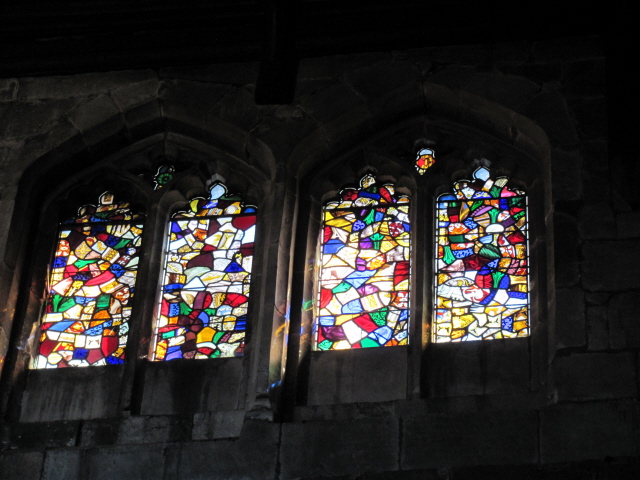Now I'm not a religious man in the slightest but I do enjoy a good church. Even today their carvings, paintings and glass impress and it's well worth a thought as to how they must have appeared to their midieval congregation. St Mary's is believed to have been founded in 970 by King Edgar on the site of an earlier Saxon church but the current building seems to date from the 12th century. Most of the stained glass in the church hasn't actually started out in this church - it seems that in the 18th and 19th century the clergymen of the church have caught a bit of a collecting bug and brought in windows of all sorts of ages and nationalities and made them fit into window spaces of the church. You'll see form the window on the left that there are on 2 kings that have arrived at the stable. Goodness knows where the 3rd king has got to but he would have been there originally when the window was made (obviously for a bigger gap somewhere.)
Now, I've failed to take any notes (or rather photograph the information label) about the above window but if I remember the above roundels built into the window are Dutch. Below is a rather maginficent rosette which is Victorian and made by David Evans who did much of the work on the churches windows, both as artist and tradesman. When 4 windows for the continent where bought and only 2 turned up Evans was called upon to build another 2 in the style of the originals.
This window on the right here, which my camera doesn't seem to have wanted to take an awfully good picture of, sums up to me what seems to have been the window policy of the church in Victorian times. The feet and stones here date from about 1532 and started out life as part of crucifiction scene from Lichfield Abbey, the canopy above the saint originally belonged to Winchster college chapel and are as old as 1380 and these have been joined together by David Evans in 1840 with a figure of St. John (minus his feet of course as they were already there).
The most impressive window in the church, above the alter, didn't start out life here either. It was in St Chads church in the town until 1788 (even then not its original home) where it collapsed into a great heap of glass and was pieced back together into the main window of St Mary's in 1792. It was made back in 1340 and features the recumbant figure of Jesse (the father of David and from whom the window takes it's name), from his loins springs a vine and effectively his family tree of 16 kings and 21 prophets until you get to Mary and Joseph and Jesus. Unfortunately they haven't put the window back in quite the order that it was intended and Jesus, Mary and Joseph appear at the bottom and Jesse starts a row up. The arched bit at the top isn't that old either being added when the window was put into it's current location.
Hidden way up on a high window is this jumble - stained glass was expensive and it seemed a waste not to use the broken and extra bits
And finally, This was in St Alkmund's rather than St Mary's and for that matter, it's not stained glass either, it's painted, but I like it, so here it is.








3 comments:
What spectacular examples of artistry and craftsmanship!
I'm constantly in awe of the differences in the concept of old between our two sides of the pond. In my neck of the woods ancient structures date back as far as 1607 when the first English settlers landed about 10 miles east of the house I grew up in.The settlers paused just long enough to give thanks for surviving the voyage before they moved up the James River and founded the first permanent English settlement at Jamestown.
There was an earlier settlement at Roanoke Island in what is now North Carolina but the entire settlement mysteriously vanished. To this day there is no explanation as to the the fate of The Lost Colony.
A couple of years ago, I had a look around a working copy of the Matthew which sailed form Bristol to Newfoundland in 1497 with a crew of 18. It was rather small for crossing the Atlantic.I shouldn't be surprised your settlers were thankful for landing as I don't recon ships would have grown much in the following 100 years.
Those stained glass windows are lovely. My favourite has to be the rosette window the colours are fantastic.
Post a Comment